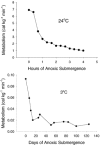Hibernating without oxygen: physiological adaptations of the painted turtle
- PMID: 12231634
- PMCID: PMC2290531
- DOI: 10.1113/jphysiol.2002.024729
Hibernating without oxygen: physiological adaptations of the painted turtle
Abstract
Many freshwater turtles in temperate climates may experience winter periods trapped under ice unable to breathe, in anoxic mud, or in water depleted of O(2). To survive, these animals must not only retain function while anoxic, but they must do so for extended periods of time. Two general physiological adaptive responses appear to underlie this capacity for long-term survival. The first is a coordinated depression of metabolic processes within the cells, both the glycolytic pathway that produces ATP and the cellular processes, such as ion pumping, that consume ATP. As a result, both the rate of substrate depletion and the rate of lactic acid production are slowed greatly. The second is an exploitation of the extensive buffering capacity of the turtle's shell and skeleton to neutralize the large amount of lactic acid that eventually accumulates. Two separate shell mechanisms are involved: release of carbonate buffers from the shell and uptake of lactic acid into the shell where it is buffered and sequestered. Together, the metabolic and buffering mechanisms permit animals to survive for 3-4 months at 3 degrees C with no O(2) and with circulating lactate levels of 150 mmol l(-1) or more.
Figures


Similar articles
-
Living without oxygen: lessons from the freshwater turtle.Comp Biochem Physiol A Mol Integr Physiol. 2000 Mar;125(3):299-315. doi: 10.1016/s1095-6433(00)00160-4. Comp Biochem Physiol A Mol Integr Physiol. 2000. PMID: 10794959 Review.
-
Physiology of hibernation under the ice by turtles and frogs.J Exp Zool A Ecol Genet Physiol. 2010 Jul 1;313(6):311-27. doi: 10.1002/jez.603. J Exp Zool A Ecol Genet Physiol. 2010. PMID: 20535765 Review.
-
Changes in the material properties of the shell during simulated aquatic hibernation in the anoxia-tolerant painted turtle.J Exp Biol. 2018 Sep 21;221(Pt 18):jeb176990. doi: 10.1242/jeb.176990. J Exp Biol. 2018. PMID: 30065038
-
Geographic variation of the physiological response to overwintering in the painted turtle (Chrysemys picta).Physiol Biochem Zool. 2004 Jul-Aug;77(4):619-30. doi: 10.1086/383514. Physiol Biochem Zool. 2004. PMID: 15449233
-
Comparative shell buffering properties correlate with anoxia tolerance in freshwater turtles.Am J Physiol Regul Integr Comp Physiol. 2007 Feb;292(2):R1008-15. doi: 10.1152/ajpregu.00519.2006. Epub 2006 Sep 28. Am J Physiol Regul Integr Comp Physiol. 2007. PMID: 17008457
Cited by
-
Developmental plasticity of the cardiovascular system in oviparous vertebrates: effects of chronic hypoxia and interactive stressors in the context of climate change.J Exp Biol. 2024 Oct 15;227(20):jeb245530. doi: 10.1242/jeb.245530. Epub 2024 Aug 7. J Exp Biol. 2024. PMID: 39109475 Free PMC article. Review.
-
Neural Processing without O2 and Glucose Delivery: Lessons from the Pond to the Clinic.Physiology (Bethesda). 2024 Nov 1;39(6):0. doi: 10.1152/physiol.00030.2023. Epub 2024 Apr 16. Physiology (Bethesda). 2024. PMID: 38624246 Review.
-
How Does Mitochondrial Protein-Coding Gene Expression in Fejervarya kawamurai (Anura: Dicroglossidae) Respond to Extreme Temperatures?Animals (Basel). 2023 Sep 25;13(19):3015. doi: 10.3390/ani13193015. Animals (Basel). 2023. PMID: 37835622 Free PMC article.
-
Low production of mitochondrial reactive oxygen species after anoxia and reoxygenation in turtle hearts.J Exp Biol. 2023 May 1;226(9):jeb245516. doi: 10.1242/jeb.245516. Epub 2023 May 10. J Exp Biol. 2023. PMID: 37066839 Free PMC article.
-
Transformation to ischaemia tolerance of frog brain function corresponds to dynamic changes in mRNA co-expression across metabolic pathways.Proc Biol Sci. 2022 Jul 27;289(1979):20221131. doi: 10.1098/rspb.2022.1131. Epub 2022 Jul 27. Proc Biol Sci. 2022. PMID: 35892220 Free PMC article.
References
-
- Bailey JR, Driedzic WR. Decreased total ventricular and mitochondrial protein synthesis during extended anoxia in turtle heart. American Journal of Physiology. 1996;271:R1660–1667. - PubMed
-
- Bennett AF, Dawson WR. Metabolism. In: Gans C, Dawson WR, editors. Biology of the Reptilia, Physiology A. Vol. 5. New York: Academic Press; 1976. pp. 127–223.
-
- Bennett AF, Ruben JA. Endothermy and activity in vertebrates. Science. 1979;206:649–654. - PubMed
-
- Bickler PE. Cerebral anoxia tolerance in turtles: regulation of intracellular calcium and pH. American Journal of Physiology. 1992;263:R1298–1302. - PubMed
-
- Bickler PE. Reduction of NMDA receptor activity in cerebrocortex of turtles (Chrysemys picta) during 6 wk of anoxia. American Journal of Physiology. 1998;275:R86–91. - PubMed
Publication types
MeSH terms
Substances
LinkOut - more resources
Full Text Sources
Research Materials


